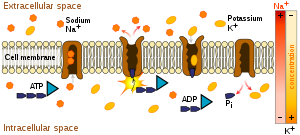The purpose of the sodium-potassium pump is to create a resting membrane potential. The resting membrane potential is the electrical potential of a cell at rest.
Active transport is the process by which substances are moved through the cell membrane, against the concentration gradient. This mans that unlike passive transport, active transport requires chemical energy from an outside source. The source of this energy is usually provided by a molecule called adenosine triphosphate or ATP. Active transport processes that use ATP are known as primary active transport while those that use an electrochemical potential difference for fuel are called secondary active transport.
One example of active transport can be seen in the cells movement of sodium and potassium across the cell membrane. This requires the use of ATP and what's known as the sodium-potassium pump.
The pump keeps sodium concentration within the cell low and outside of the cell high while the opposite applies to concentrations of potassium. This is accomplished by the pumping of sodium and potassium ions (charged particles) in opposite directions across the membrane.
